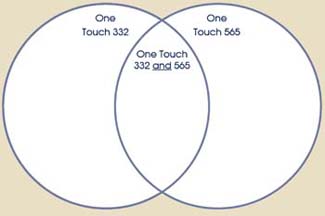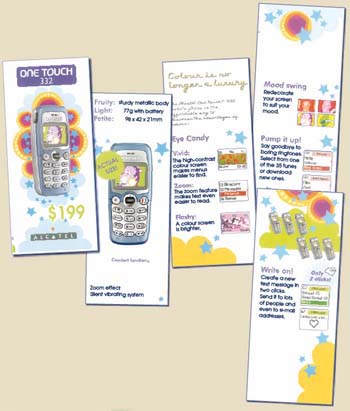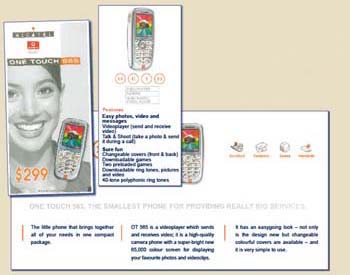|
|||||||||||||||
|
|||||||||||||||
%
responses 2009 ('05) |
|||||||||||||||
y8
|
|||||||||||||||
 2. Fill in the diagram to help Emily choose a phone. 2. Fill in the diagram to help Emily choose a phone. Make notes about each phone in the circles. Where the circles join, write the things that are the same about the two phones. |
|||||||||||||||
| 3. Circle the phone that Emily should buy. One Touch 332 One Touch 565 | |||||||||||||||
| Relevant features: (menu easy to find; text menus easy to read; screen can be changed; sturdy metallic body; lightweight (77g); small size (98x42x21 mm); zoom effect; silent vibrating system; $199) |
|||||||||||||||
5 or more relevant features |
2 (3) |
||||||||||||||
3-4 relevant features |
16 (14) |
||||||||||||||
1-2 relevant features |
54 (56) |
||||||||||||||
| Relevant features: (video player; camera; $299; changeable colour screens; take photo and send while talking; downloadable games; can be used for news & information) |
|||||||||||||||
5 or more relevant features |
7 (9) |
||||||||||||||
3-4 relevant features |
31 (32) |
||||||||||||||
1-2 relevant features |
45 (46) |
||||||||||||||
| Use of Venn Diagram: |
|||||||||||||||
diagram filled in correctly |
73 (77) |
||||||||||||||
information for each phone correct
BUT intersection of circles not used |
8 (6) |
||||||||||||||
| 4. Why is this the best phone for Emily? | good justification |
21 (25) |
|||||||||||||
some justification |
48 (43) |
||||||||||||||
Total
score: |
9–10 |
3 (4) |
|||||||||||||
7–8 |
18 (20) |
||||||||||||||
5–6 |
39 (39) |
||||||||||||||
3–4 |
22 (20) |
||||||||||||||
0–2 |
18 (18) |
||||||||||||||
| Subgroup Analysis [Click on charts to enlarge] : |
| Commentary: |
| Year 8 students were moderately successful at comparing different cell phones using a Venn diagram. They were able to find some features to enter into the diagram, but typically did not list many features, nor were they able to provide strong justifications for their choices. Performance was very similar in 2005 and 2009. Girls outperformed boys and Pakeha students outperformed Mäori and Pasifika children. |


